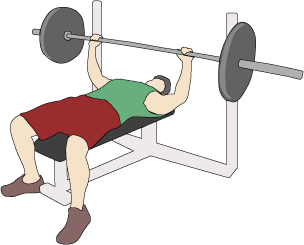The Bench Press Beep Test is an upper body muscular strength endurance test in which the participants perform as many repetitions as possible at a set weight and set cadence. A similar test was once part of the NHL pre-draft testing combine (they now use a different protocol). See also the bench press test where the athletes bench as many times as they can at a set bar weight with no cadence restriction, and the NHL push-up beep test.
test purpose: to measure maximum strength endurance of the chest muscle groups.
equipment required: a standard padded bench with safety catch, standard weight bar with 150 lb. total weight (including the bar), bench press mp3 file or metronome (you can use you can use the online push-up metronome or another indicator of rate - you can also make your own using the team beeptest software).
pre-test: Explain the test procedures to the subject. Perform screening of health risks and obtain informed consent. Prepare forms and record basic information such as age, height, body weight, gender, test conditions. Perform an appropriate warm-up. See more details of pre-test procedures.
procedure: The metronome or other timer is set at a rate of 25 per minute (set the metronome at 50 so that the click signals either the up or down movement). The athlete begins by lying in a supine position on the bench, with their feet flat on the floor and the upper and lower back in contact with the bench at all times. The bar is grasped shoulder width apart. The starting position of the bar is touching the chest at approximately the axillary line and the bar is pushed up to full extension of the arms. Bench press actions are performed in time with the metronome. Record the number of consecutive repetitions completed before the player falls behind the cadence.
variations: Other barbell weights can be used, 150lb is used as an example for it is the weight used for the NHL testing. The press up beep test is very similar, and other bench press tests include no cadence with set weight and relative weights.
scoring: the maximum number of complete repetitions successfully performed is recorded.
advantages: with the exception of a metronome, the required equipment is readily available in most gymnasiums, and the test is simple to perform. Using a set cadence, the movement is more controlled and correct technique is easier to monitor.
disadvantages: This test should only be performed by those experienced at performing the bench press lift with good technique. Good technique will also enable the lifter to maximize their score. Using a set weight may disadvantage lower weight athletes. It is sometimes difficult to determine the end point, as determining the moment at which the participant falls behind the beep can be subjective.
comments: For safety, a spotter should stand at the head of the bench throughout the test.
Similar Tests
- Other similar tests: bench press maximum and relative bench press.
- See the similar Bench Press 1RM fitness tests.
- See the NHL push-up beep test which is at the same cadence.
Related Pages
- Bench Press MP3 file for conducting this test
- More about Bench Press Fitness Testing
- Online push-up metronome
- This test was once part of the NHL pre-draft testing combine.
- See video examples of bench press testing in action.
- Information about bench press technique


 Current Events
Current Events